The highs and lows of living with juvenile diabetes

Godwill Njuru, 22, at their home in Murang’a County.
What you need to know:
- Common signs and symptoms : Sudden severe weight loss, excessive thirst and hunger, bed wetting (for children who were dry), blurring of vision, recurrent infections, poor wound healing.
- Disease management: Fast or rapid-acting-insulin injected three times daily before meals, and long-acting-insulin taken two hours after dinner before going to bed. Best practice is to use an insulin pump (artificial pancreas) which consists a pump and glucose monitor. The device/algorithm monitors your blood sugar and reduces the burdens involved in self-management of diabetes on a minute-by-minute basis.
“Life can be quite tragicomic at times. A boy afraid of needles was forced to confront his fears head on as his life literally depends on them. Today, that boy – now a young adult, has to contend with four insulin injections every day without fail.
My name is Godwill Njuru, 22. I hail from Murang’a County. I am the firstborn in a family of two and a trained plumber. I just finished my course last year in November. My two decades of existence beneath the sun feel like a lifetime as for the past seven years I have been in a perpetual battle with type 1 diabetes.
I had a fairly healthy life from childhood and never suffered any major ailment. But when I joined high school in 2016 at the age of 16, I started having health issues. Unbeknown to me this was just the beginning of a long tumultuous journey ahead of me in uncharted waters. During third term I was diagnosed with peptic ulcers and gastritis and so going to Form Two, I would sometimes miss classes as I sought treatment.
From there things only got worse during the second term holiday. August, 23, 2017 is a day engraved in my memory with indelible ink. I had started experiencing strange symptoms when I came home. Frequent urination, fatigue, restlessness, and this unquenchable thirst. The symptoms would mostly present at night and sometimes last till morning. So on this day I woke feeling sick and my mum had me take a fasting blood sugar test. The readings came back exceedingly high so she rushed me to a local dispensary, where the doctor advised us to seek help at a bigger facility.
After a long day of numerous tests and an even longer talk with the doctor, I was told I had type 1 diabetes. I remember on our trip back home all I kept thinking was, ‘what just happened?’ I could not reconcile the fact that I was sick with a disease I barely knew about. It was six days from the school reopening date and here I was trying to internalise all the instructions the doctor had given me. I knew my life was never going to be the same again, at this point feeling like a spectator watching my own life rush past me. I was taken to see a specialist in Nairobi a few days later and this is when I learnt I would need insulin injections every day for the rest of my life. I just had to make room in my life for the all familiar prick of a needle as this was going to be my life going forth.
Back in school, I had to learn how to monitor and manage my sugars, observe a strict diet and refrigerate my insulin, and all these changes meant one thing — I could no longer attend a boarding school. So I transferred from an extra county school to a day school near home , where I could better manage my health. The journey ahead of me was still not clear in my mind, but the first struggle I encountered was managing my diet. When I was with my peers and they were having junk food and snacks, it was quite hard to keep off and sometimes I would give in to my appetites. I was also having trouble with eating many small food portions as opposed to a normal eating routine.
When I started the insulin injections, I gained weight fast. None of my clothes could fit anymore as I used to be a skinny boy and I could see the looks people were giving me. I started feeling conscious and anxious around people. I tried exercising but it was not helping much.
Another side effect of insulin use was hypoglycaemia, which was so severe at times I could become unconscious even for an hour. Sometimes this would happen while in class and I’d get admitted to hospital for days on end. I would also experience numbness in my legs and get constant muscle pulls, sometimes being forced to use a walking stick. However, as time progressed and towards completion of my studies in 2019, I had learnt to manage my condition better and note signs early enough before they got worse.
The financial implications were also severe on my family. When I started using insulin I would spend about Sh20,000 monthly on medical bills alone, not to add my special diet needs, as well as those of the family. I could tell my mother was struggling as her business was going down, and this stressed me as well. Luckily in 2019, my primary doctor recommended me to a hospital in Westlands that helps diabetics and I was able to cut my costs by half after discounts.
When Covid-19 hit in 2020 and a movement restriction was imposed, I could no longer attend regular clinics and my health took a turn for the worse, and I had to start all over again. By the beginning of the following year my mother could no longer sustain my bills, but the hospital came through for me again by offering me free medical services. The only cost I would incur now was fare during my clinics.
I have seen dark days I could never have dreamed of in my worst nightmares. When my peers were celebrating finishing school and Christmas in 2019, I was praying and fighting for my leg as I had gotten diabetes foot. And there are so many other things that I cannot even talk about yet. But through it all I have persevered with the immense support of my friends and family. It’s not always easy, but I have learnt to take each day at a time, as it comes. Through my journey, I have been able to help two of my friends who were pre-diabetic and did not know, but I was able to observe based on what I have gone through. The reason I choose to share my story is to let someone who is going through a similar situation, or any other fight for their health, know that they are not alone. Someone somewhere in the world empathises with them and understands their fight. I also believe we all have a role as a community in supporting people with chronic conditions, rather than stigmatising them. Because given a choice, we would all pick perfect health.”
About type 1 diabetes
Dr Erick Njenga – Senior consultant, diabetologist/endocrinologist, Aga Khan University Hospital, Nairobi
Common signs and symptoms – sudden severe weight loss, excessive thirst and hunger, bed wetting (for children who were dry), blurring of vision, recurrent infections, poor wound healing.
Disease management – fast or rapid-acting-insulin injected three times daily before meals, and long-acting-insulin taken two hours after dinner before going to bed. Best practice is to use an insulin pump (artificial pancreas) which consists a pump and glucose monitor. The device/algorithm monitors your blood sugar and reduces the burdens involved in self-management of diabetes on a minute-by-minute basis.
Insulin use complications – the most critical side effect of insulin use to watch out for is hypoglycaemia (low blood sugar levels). Severe and frequent hypoglycaemia can lead to, and accelerate destruction of internal organs, lead to cardiovascular complications, and lower life expectancy.
Signs include; headaches, confusion and dizziness, shaking and tremors, excessive sweating and unconsciousness (hypoglycaemic coma which is a medical emergency).
Immediate management of hypoglycaemia is ingesting carbohydrates-high foods such as juice or glucose





